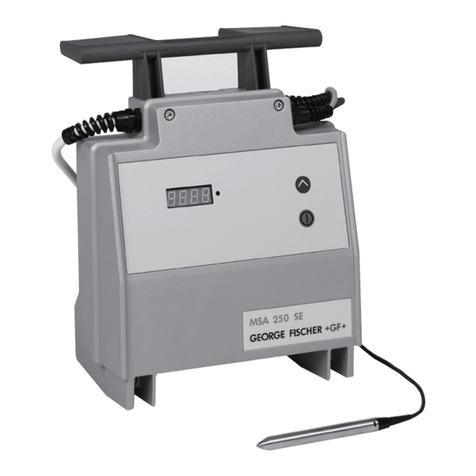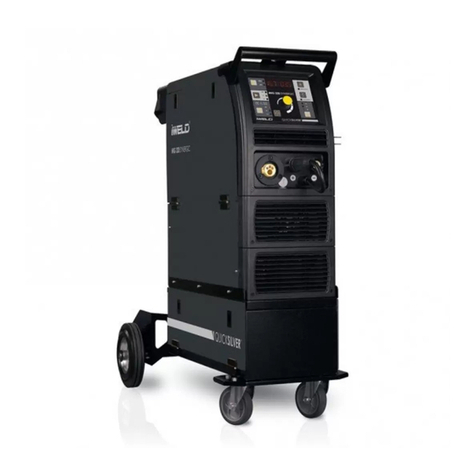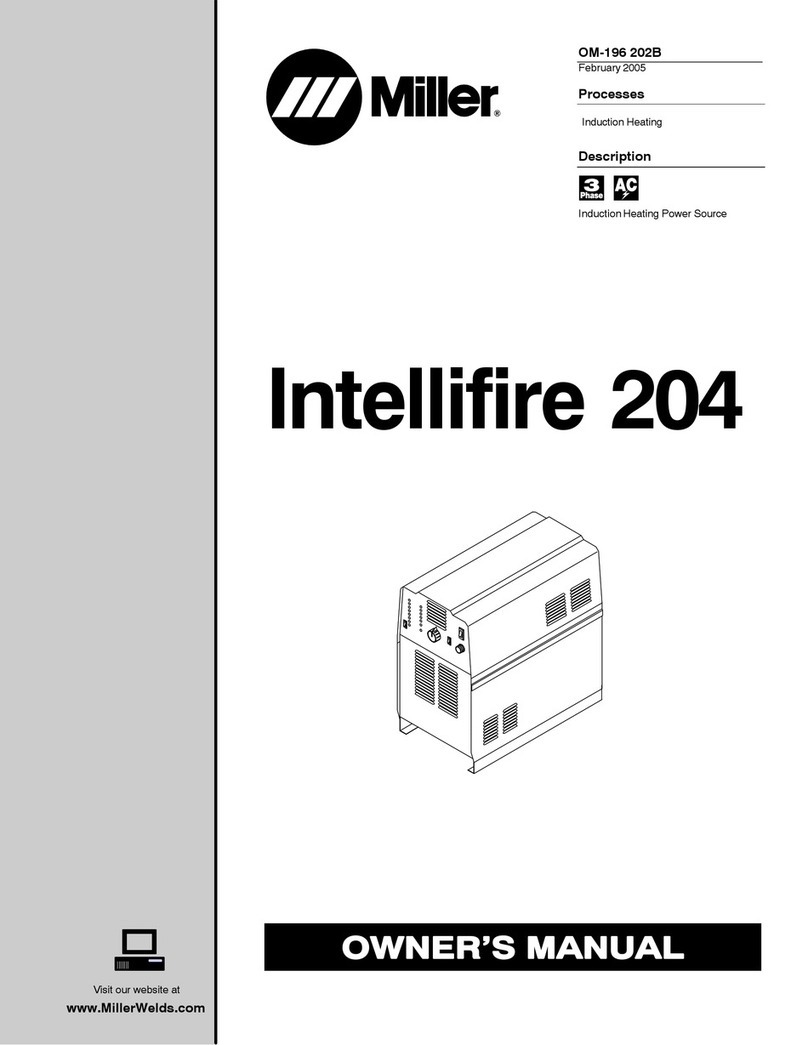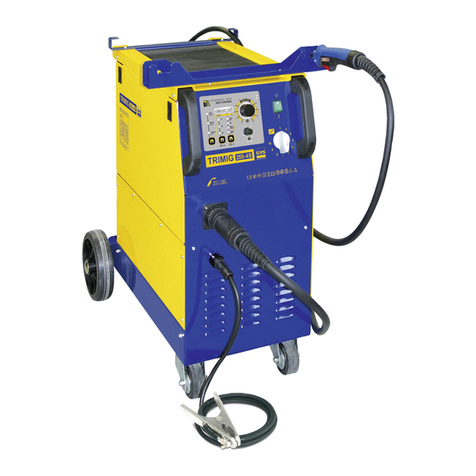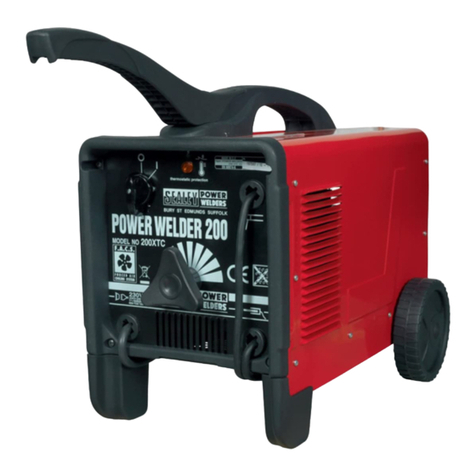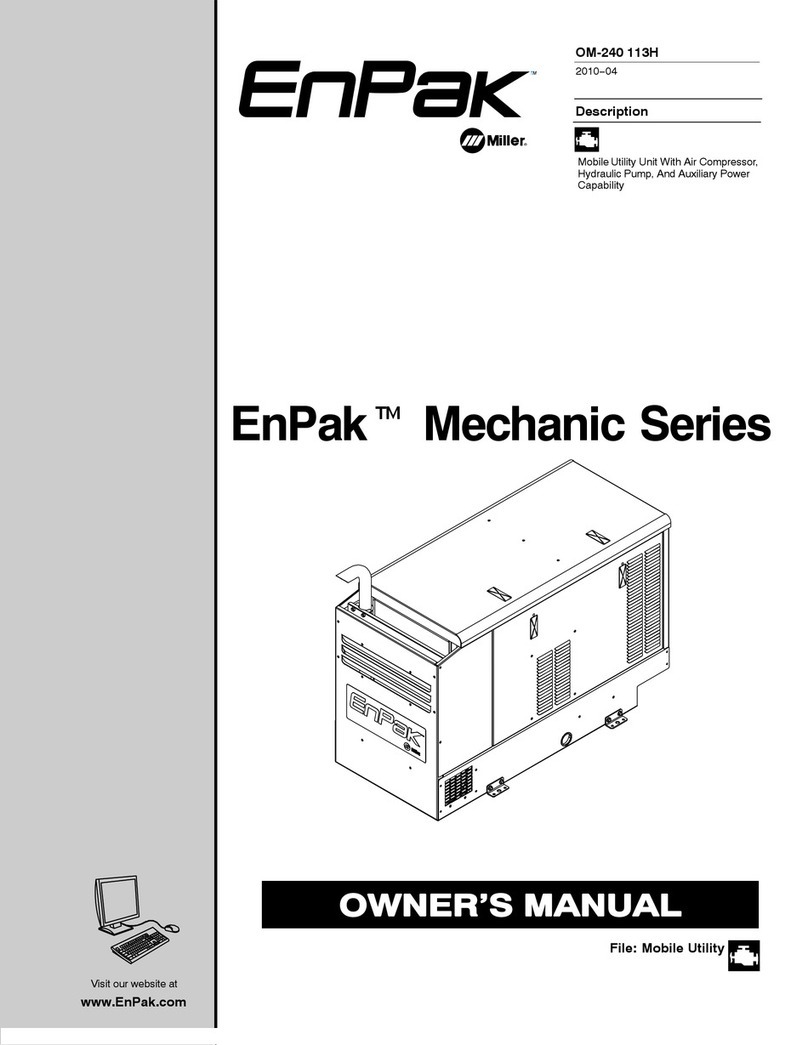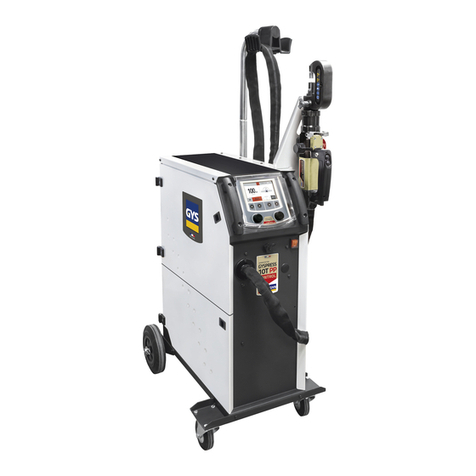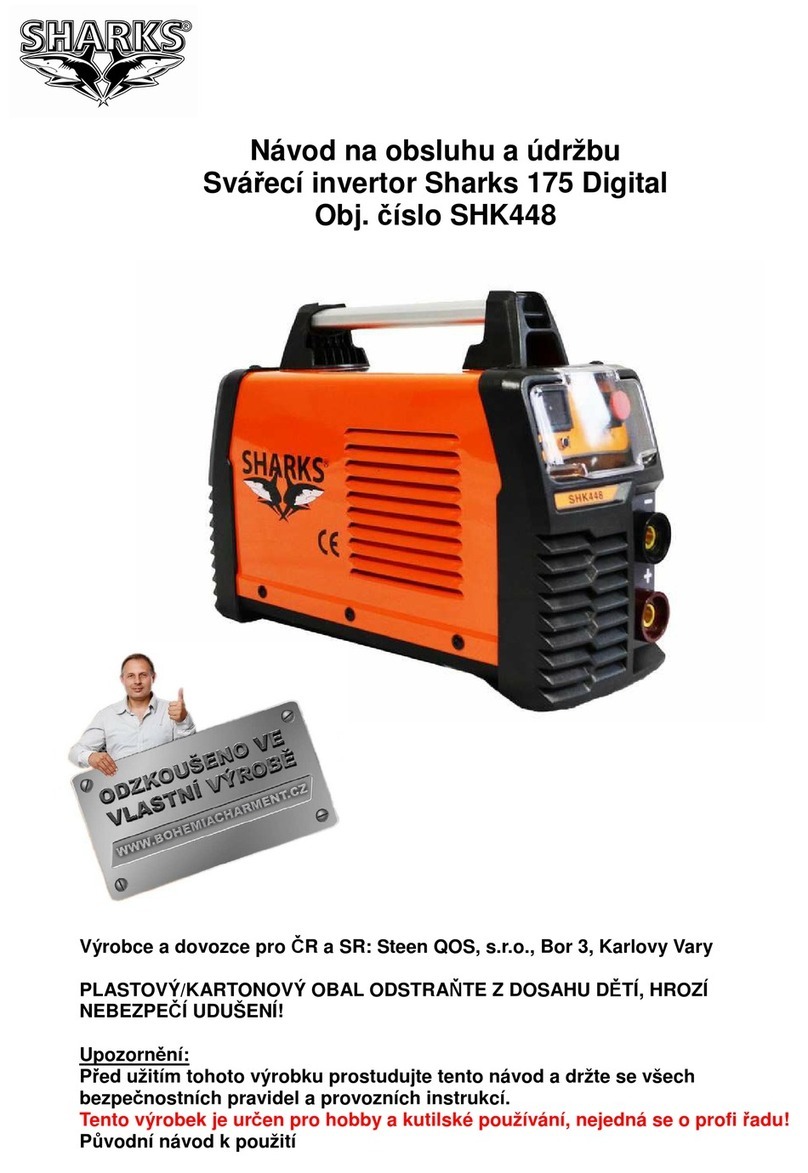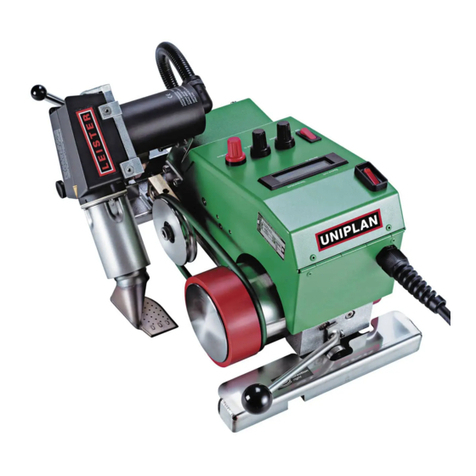GEORGE FISCHER SG 160 User manual

Instruction Manual
Combination Butt and Socket Fusion
Machine SG 160
for Processing Plastic Pipes.

Notice:

Dear customer,
ask your sales and service centre to explain
and to show all functions of the welding
machine. Before putting the unit into operation
you have to read and understand the operating
manual and in particular the safety instructions.
By this operating manual you will be instructed
of the correct use and informed about the safety
rules of this welding machine. This operating
manual is to be stored in a safe place to allow
future reference.
The operating manual includes no guarantee pro-
mises, it gives you only the technical know how.
Please see our general conditions of sale and
delivery.
The instruction manual belongs
to machine no.:
Without express permission no text nor illu-
strations may be copied or reproduced in any
from (by printing, photocopying, microfilm
or other processes) or made available to third
parties ©.
Only the German version of this operating
manual is binding in law.
3

4
Table of Contents
1. Safety
1.1 Safety definition
1.2 Workshop safety
2. Technical Data
2.1 Characteristic Data
2.2 Range of Applications
2.3 Type Description
2.4 Subassemblies - Overview
3. General
3.1 Introduction
3.2 Range of Applications
4. Transport
4.1 Packaging
4.2 Disassembly
4.3 Sensitivity
4.4 Intermediate Storage
4.5 Contents
5. Design and Mode of Operation
5.1 Design and Mode of Operation
5.2 Accessories
5.3 Butt Fusion Version/Accessory Parts
5.4 Socket Fusion Version/Accessory Parts
5.5. Installation
6. Starting Operation
6.1 General Information
6.2 Preparing for Butt Fusion
6.3 Preparing for Socket Fusion
7. Operation
7.1 Basics of Butt Fusion
7.2 Preparing for Butt Fusion
7.3 Fusion Tables/Fusion Process
7.4 Special Cases in Butt Fusion
Page
6
6
6
9
9
9
9
10
11
11
11
12
12
12
12
12
12
13
13
13
14
14
15
16
16
16
18
21
21
22
24
32

5
7.5 Failure Analysis in Butt Fusion
7.6 Basics of Socket Fusion
7.7 Preparing for Socket Fusion
7.8 Fusion Tables/Fusion Process
7.9 Special Cases in Socket Fusion
7.10 Failure Analysis in Socket Fusion
8. Maintenance
8.1 Periodic Maintenance
8.2 Replacement of Worn Parts
8.3 Setting the parameter
8.4 Calibrating and programming
8.5 Basic adjustment
8.6 Change from programming
33
35
35
37
41
42
44
44
44
45
45
47
48

1. Safety instructions
1.1 Safety definition
Safety instructions
Safety instructions you have to read and to
follow are marked in the operating manual. The
non attention to this instructions may lead to
severe physical injury or death.
Important information
Important information are marked in the
operating manual. The non attention may lead
to malfunction or to damage of the machine.
1.2 Workshop safety
Give special attention to the following
safety rules! The welding machine for plastic pipes
SG 160 is built on todays technology and
corresponds to the general workshop safety if it is
used as prescribed. Using the machine by
uninstructed people or by non attention to the
safety rules may be dangerous to persons
and to the equipment.
The equipment should be operated only by instruc-
ted people. Each person, which is involved
in the preparation, set up, operating and mainte-
nace (Inspection, maintenace, repair) of the
SG 160, should have been reading and should
have understood the operating manual, especially
the information about safety.
6
!
!

Correct use of the machine
– The SG 160 is exclusively for the butt and
socket fusion of defined plastic in the
prescribed dimension range.
All other uses are not allowed.
No liability whatsoever can be accepted
for damage or injuries caused by disregarding
the rules in the operating manual.
– Only original parts and substances from the
official supplier should be used for a guaranteed
use of the machine.
– A daily visual check up of the SG 160 has to
be done. Damages and defects have to be
repaired. Repairs of the electronics have to be
done through the official supplier. The machine
has to be protected from humidity, dirt, dust
and hits.
Be conscious about safety
Give your own contribution for the safety in
the workshop. A deviation to the normal operating
behaviour should be reported to your manager.
All operations have to be done with highest
precaution. For your safety and quality work you
should have a clean and a good organized
working site.
7
!
!

8
Especially dangerous are the heating element
and the planing element. The heating element and
the planing element may only be operated by
the special handles.
Never touch the planing element at the surface.
It contains two shaving blades.
The heating element is heated up to 210° C
(410° F) while in operation, in the heating up or
cooling down time. The danger of physical
injuries by burning has to be observed. Never use
any liquids to cool down the heating element.
Precaution is asked when the machine is in
operation. No member of the body or external
parts should be in the sliding elements of the
machine.
Because of safety regulations and health care the
machine and the heavy elements (over 30 kg /
60 pounds) should be never lifted by only one
person.
The electrical wires should be protected from
injuries (knifes, borders). Damaged electrical wires
should be replaced by the official supplier.
Recycling
Recycle or dispose waste materials such as
cuttings aso in conformity to the law as well as to
the ecological ethics by a specialist or by the
vendor.
Other safety rules
National law, standardizations and rules have to
be observed.
!

2. Technical Data
2.1 Characteristic Data
Machine Description:
Plastic Combination Fusion Machine
Machine Type: SG 160
Machine Nr.: page 3
Weight Basic Model: 45 kg
* Technical data and illustrations in this manual
are the actual stand as of January 1, 1997.
2.2 Range of Applications and Authorized
Usage
The SG 160 is made exclusively for the fusion
jointing of plastic pipes, fittings and valves. Any
other use is not authorized. The manufacturer is not
liable for any damage resulting thereof; the user
carries sole responsibility.
2.3 Type Description
SG SchweissGerät (Fusion Machine)
160 max. Pipe/Fitting Diameter
9

2.4 Subassemblies - Overview
The following subassemblies are contained in the
basic package.
2.4.1 Machine Base with Slide
Machine base of steel sections welded with four
handles on the side. Two tempered, chrome-plated
guide shafts for the slide. Tempered, chrome-plated
guide shafts for the heating plate and the planer.
Left slide movable with sealed bearings. Lockable
star knob to move the left slide and for pressure
buildup via an accordingly dimensioned pressure
spring.
2.4.2 Planer
Planer of cast aluminum, adjustable in axial
direction; swivels in and out.
Motor: Electromotor 750 Watts
Voltage: 230V/50 Hz or 115V/60 Hz
2.4.3 Heating Plate with Digital Temperature
Indicator and Replaceable PTFE Cover.
Heating plate, adjustable in axial direction;
swivels in and out.
Power: 1400 Watts
Temperature distribution
on heating plate: +/- 4° C
Voltage: 230V/50 Hz or 115V/60 Hz
10

11
3. General
3.1 Introduction
It is intended that this information be read,
understood and observed in every point by all
persons who are responsible for the SG 160.
The complete technical documentation should be
kept in the vicinity of the SG 160. Especially
important details for the use of the SG 160 are
noted in this Manual. This Manual must be
observed if failure-free operation of the SG 160 is
to be warranted. It is, therefore, important that the
responsible persons are familiar with this Manual.
We recommend that this Manual is read carefully
before putting the SG 160 into operation, since
we are not liable for damage or breakdowns
which are the result of noncompliance with this
Manual.
Should there nevertheless be a problem,
please contact the nearest representative (see the
last page).
This Manual is only valid for the SG 160.
The specifications in this Manual are subject to
modification if technical changes are necessary to
improve the SG 160.
3.2 Range of Applications
Plastic fusion machines are designed for the
jointing of thermoplastic piping systems. The
SG 160 is constructed for two different fusion
procedures: butt fusion (d32 - d160) and
socket fusion (d16 - d110).
Attention!
!

12
Fig 1.
4. Transport
4.1 Packaging
A decisive factor in the choice of packaging is the
means of transport.
4.2 Disassembly
It is basically possible to disassemble the SG 160
into several subassemblies. The unit is usually
transported in a condition as complete as possible.
4.3 Sensitivity
Special care must be taken when transporting the
SG 160 in order to prevent damage from impact
or improper loading and unloading.
All movable parts must be secured.
Fig. 1
Transport insurance should be provided for
according to the type and duration of the
transport. Condensation due to large fluctuations in
temperature as well as sharp jolts during transport
should be prevented.
The SG 160 is to be handled with proper care.
4.4 Intermediate Storage
If the SG 160 is not installed immediately upon
receipt, it must be stored in a protected place. The
unit should be properly covered.
4.5 Contents
The contents should be checked in their entirety
upon receipt. Any transport damage and/or
missing parts should be reported in writing
immediately.The complaint should be noted directly
on the shipping papers and counter- signed by the
freight forwarder.

13
Normal accessories
– 1 Timer
– 1 fusion shedule
– 1 Instruction Manual
– 1 support to y-shaped pipe support, left
– 1 support to y-shaped pipe support, right
– 2 y-shaped pipe support D = 16–32,
D = 40–63, D = 75–125, D = 140–160
– 1 socket wrench wo 13
– 1 hex wrench wo 6
– 1 hex wrench wo 8
– 1 pin-type wrench set
– 1 pan head screw M8 x 60
– 1 pan head screw M8 x 70
5. Design and Mode of Operation
5.1 Design and Mode of Operation
The SG 160 is designed as a combination fusion
machine, equipped for both butt and/or socket
fusion.
The design is based on the modular principle.
With the accessory parts, user-specific needs can
be easily met.
The SG 160 is operated manually.
5.2 Accessories

14
5.3 Butt Fusion Version
Accessory Parts
5.4 Socket Fusion Version/
Accessory Parts
Handweel for moving the
slide
Handweel for moving the slide
Clamping device LEFT
Clamping device
RIGHT
Heating plate
Heating plate
Clamping bracket RIGHT
Clamping bracket LEFT
Insert
V-support
Heating spigots and
bushes
Basic clamping plate
RIGHT Basic clamping plate LEFT
Clamping jaws
Peeling tool
Pick- up device for basic
clamp plate LEFT
Planer with pick-up
for peeling and
chamfering tools
Planer with pick-up
for peeling and
chamfering tools
Digital temperature
control/indicator

15
5.5 Installation
The installation of the SG 160 should be done
according to specifications in order to ensure safe
and optimal operation.
The transport crate is designed as a work bench.
Fig. 4
Weight: 130 kg
Dimensions: Height 1000 mm
Width 800 mm
Length 1200 mm
The machine can be lifted out when the clamps
are released. When the lid is closed, please see
that the machine is placed in the provided
mounting slots.
Fig. 5
For other methods of installation, for example on a
stationary work bench, it is recommended that the
SG 160 is fastened to the bench with a clamp in
order to prevent it from moving during the fusion
process.
Before switching on the machine, compare the
mains voltage with the input voltage.
Fig. 4
Fig. 5
Attention!

16
6. Starting Operation
6.1 General Information
Proper training of the operating personnel has a
great influence on the optimal functioning of the
SG 160.
6.2 Preparing for Butt Fusion
The machine can be prepared for butt fusion in
only a few steps.
Loosen the knurled-head screw. Pressure is now
built up via spring tension.
Fig. 6
The groove in both eccentric screws (in front and
at the back) should be horizontal and secured with
the safety screw. The heating plate can be moved
axially.
Fig. 7
Adjust the rotation direction of the planer with the
lever (subjekt to change), as seen from the motor
side, clockwise.
Fig. 8
Fig. 6
Fig. 7
Attention!
Fig. 8

17
Mount the inner basic clamping plates left and
right.
Install the inserts and the left and right clamping
brackets for the corresponding dimensions.
Fig. 9
For additional support, Y-supports are available.
Fig. 10
When joining long pipe pieces, it is
recommended that the outer basic clamping
plates are used.
Set the needed temperature
– press shortly the P-key (< 3 sec.)
– press shortly UP-or DOWN key to set
step by step
or keep pressing for fast set
See guidelines in the fusion tables on pages
25–29.
The set temperature can be read by pushing the
P-key.
Fig. 11
In case of operation problems please check
chapter 8.3, page 45.
Do not press any key uncontrolled in the
programming operation.
Now the SG 160 is ready for butt fusion.
Fig. 9
Fig. 11
Fig. 10
Attention!

18
Fig. 12
Fig. 13
Fig. 14
Fig. 15
6.3 Preparing for Socket Fusion
Usually on the SG 160, the fitting is clamped on
the right and the pipe on the left, as seen from
the user’s side. If necessary, the machine can be
prepared or rebuilt at a later time for the
opposite clamping version. The following
instructions refer to the fitting being clamped on
the right side.
Mount the disengaging device on the fitting side
(in our example on the right).
Fig. 12
Mount the depth stop in such a way that the
locking fork points toward the fitting side.
Fig. 13
The stops on the depth stop must be set
according to the following standards:
The aluminum stop must always be in the shown
position.
Fig. 14
Screw in the knurled-head screw. The spring will
become disengaged and a direct pressure build-
up is possible.
Fig. 15
87,5
60
29,5 14

19
The groove in both eccentric screws (in front and
at the back) should be vertical and secured with a
safety screw. The heating plate can now be
moved radially.
Fig. 16
Mount heating bushes and spigots. The heating
bushes may not be scratched or damaged in any
way.
The fusion surfaces must be clean.
The screws should be tightened only after the
fusion temperature has been reached.
Fig. 17
Adjust the rotation direction of the planer with the
lever (subjekt to change). The rotation direction of
the planer, as seen from the motor side, is
counterclockwise.
Fig. 18
Use the peeling tool for the corresponding
dimension.
Fig. 19
Move the clamping device on the slide to the end
screws and tighten with the special wrench.
Fig. 20
Fig. 19
Fig. 20
Fig. 16
Fig. 17
Fig. 18
Attention!

20
Fig. 24
Fig. 22
Fig. 21
Fig. 23
Mount clamping jaws. These are marked with the
respective dimension ranges.
Type 1 30-50/50-90
Type 2 16-30/90-125
Fig. 21
For additional support, Y-supports are available.
Fig. 22
When joining long pipe pieces, it is
recommended that the outer basic clamping
plates are used.
Set the needed temperature
– press shortly the P-key (< 3 sec.)
– press shortly UP- or DOWN key to set
step by step
or keep pressing for fast set.
See guidelines in the fusion tables on page
38 – 39.
The set temperature can be read by pushing
the P-key.
Fig. 23
In case of operation problems please check
chapter 8.3, page 45.
Do not press any key uncontrolled in the pro-
gramming operation.
The fusion set temperature should be checked on
the fusion tools with tempil sticks or an
appropriate, fast responding, temperature
measurement device.
Fig. 24
The SG 160 is now ready for socket fusion.
Attention!
Table of contents
Other GEORGE FISCHER Welding System manuals
Popular Welding System manuals by other brands
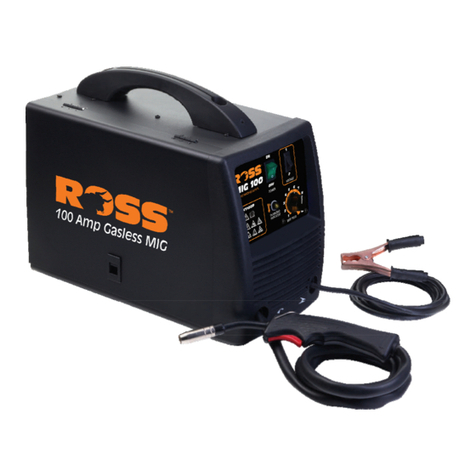
Ross
Ross RXT100P General Instruction

Schweissen Schneiden
Schweissen Schneiden Inverspotter 13500 Aqua instruction manual

Migatronic
Migatronic MIGACUT 5i instruction manual
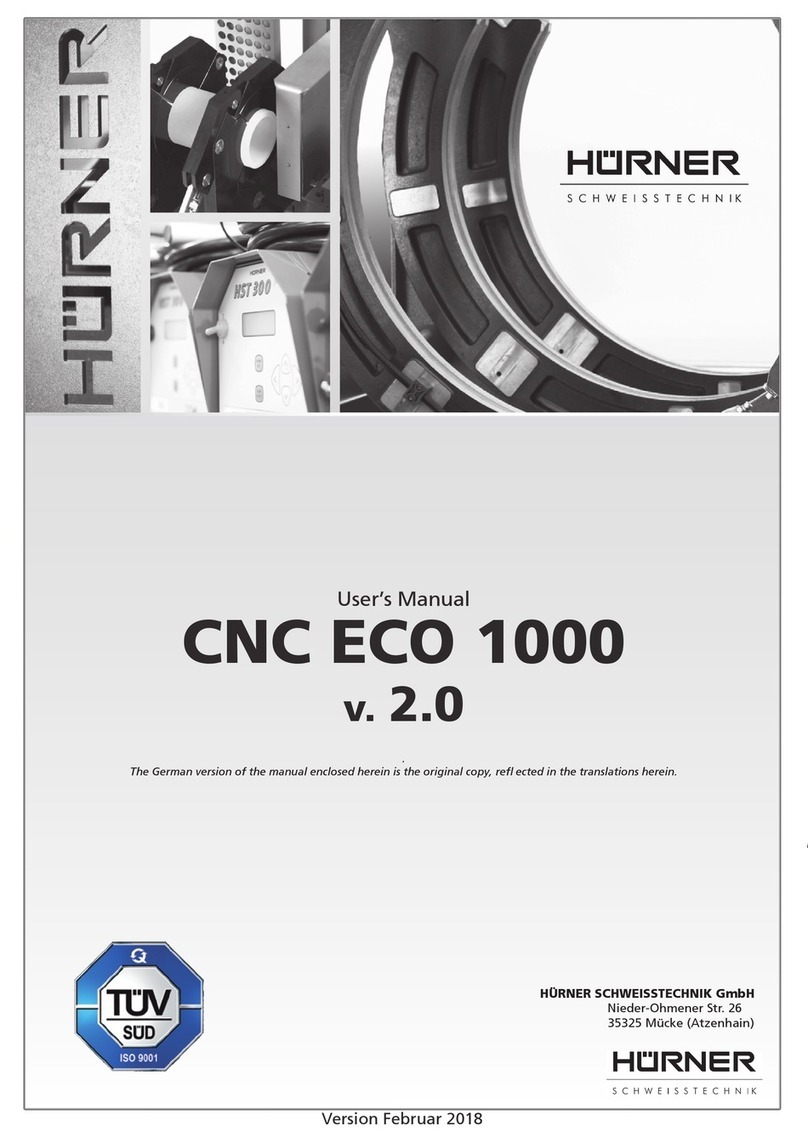
HURNER
HURNER CNC ECO 1000 user manual

Lincoln Electric
Lincoln Electric 11499 Operator's manual
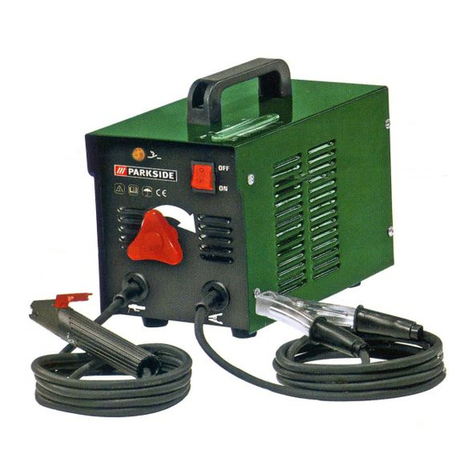
Parkside
Parkside PESG 120 A1 operation and safety notes original operating instructions
